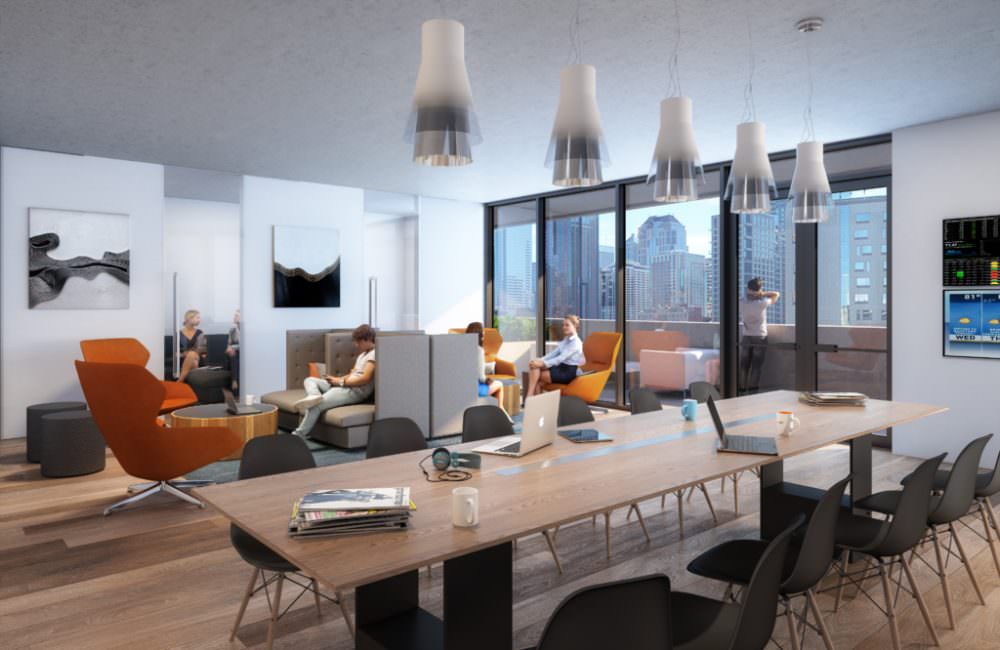Originally written by former WT Senior Associate, Rachael Bauer.
We’ve all received the evil eye from the barista when we occupy real estate for hours in the coffee shop trying to work remotely. Or distractions and failing technology prevent us from working at home. Perhaps we simply want to work in the presence of other people. Whatever the reason, we’ve seen coworking spaces take off in a variety of forms to help solve some of these issues.
In 2018, “The Collective” opened in the South Lake Union neighborhood of Seattle which offers an urban gathering space that can be used for coworking, socializing and forming a community. However, this comes with additional monthly costs through membership fees and also possibly commuting costs.
As an alternate to paying to use a public work environment, coworking spaces are becoming more and more popular in new multifamily (apartment and condominium) development. Key advantages of these spaces is that they’re restricted to residents and their guests, which ensures availability of space, and being located in the building makes them convenient while also allowing separation of home and work.
Local developer Martha Barkman, Vice President of Development for Mack Real Estate Group, has observed that “Residents looking for co-work space with multi-family buildings range from the individual freelancer to those that have dedicated office space outside the building but are seeking collaborative space outside their office or want have an informal meeting with others outside the workplace.”
More developers are taking notice. One of our current condominium projects, Nexus, developed by The Burrard Group, is devoting a large portion of amenity space (about 1,900 SF) to co-working. According to Christian Chan, Executive Vice President of The Burrard Group, “the developer firmly believes in two major philosophies which drove the design for Nexus’ coworking spaces: 1. Human centered design to cater directly to users and not just provide the status quo, and 2. Activity based planning – ensuring the function of the space is supported by the design of the space.”
We worked closely with The Burrard Group to thoughtfully address the reasons workers seek this alternative work environment and created an attractive amenity for buyers. The furniture is high quality and comfortable to support longer work sessions. The variety and arrangement of furniture accommodates both individuals and groups because as Chan points out, “you can’t force everyone into an open office environment, but rather you need a robust mix of spaces.”

Rendering of the co-working space at Nexus.
Privacy is met through personal phone or work rooms complete with media that can support group meeting opportunities, webinars and phone conferencing. Ample outlets are located in nearby walls, the floor, as well as in work tables, booths and community and conference tables. Thoughtfully planned acoustics include ceiling treatments and wall construction, as well as acoustical wall applications at media spaces and the like. Top notch technology is executed into these spaces for all coworking needs.
Multi-functionality
Though it is important for these spaces to cater to remote workers during key business hours, it is equally imperative that these spaces are multifunctional and allow for other uses during evenings and weekends to remain lively. According to Barkman, “It’s essential to bring coworking opportunities into community spaces, but not necessarily dedicate space to coworking as its sole purpose.”
Zoning the spaces is key. Whether used by remote workers or by different social groups, it’s important to find a way to divide the large community spaces so that the space doesn’t lend itself to just one large social setting. Should someone choose to work remotely during nontraditional business hours, separately zoned areas within the space or individual work/phone rooms still allow them to do so, while other more social activities are happening as well. Many tenants gravitate toward the rooftop amenity perimeter and prefer to work alongside some of the best views in the building.
Location, location, location
Historically, the “business center,” has been an enclosed, remote space deep within a multifamily building with potentially little to no views, much less windows. Today’s workers don’t want their work environment to be an afterthought. To combat this at Mack Real Estate’s 1001 John project (Architecture by CollinsWoerman, Interior Design by Weber Thompson) the coworking space is integrated into the first level experience as well as the overlooking mezzanine. It also allows for easy meeting room access off the lobby for the resident tech worker and other team members (non-residents) to meet outside of the office.
This type of coworking space may sound like it is taking up valuable real estate but it is purely replacing much of the traditional business center and leasing office programming. Today’s remote worker doesn’t need their own fixed workstation and use of printers as long as there is power, wifi and access to a room for the occasional meeting or private work space. The Leasing staff don’t require dedicated space as long as they have the ability to work in the multifunctional coworking space as well.
What does this mean for developers looking to find the right design team?
As we continue to see blurring lines separating home from work, designers will need to be more well-rounded and experienced to provide the best for clients. At Weber Thompson we bring our knowledge in both residential and commercial office design to the table for our projects. Our passion for both allows us to bring this new vision of a coworking space to life for our clients.